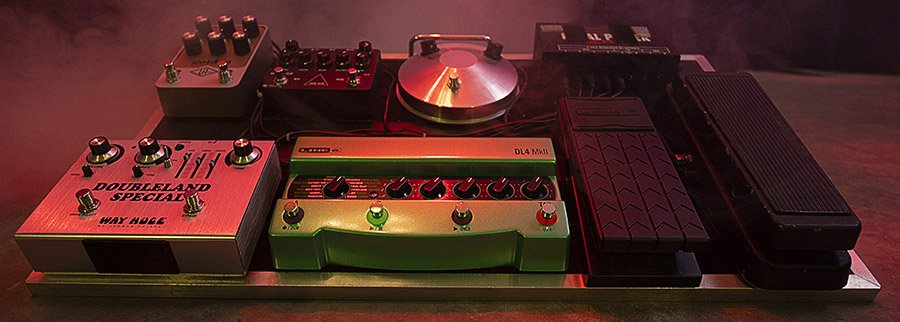DL4 MkII FAQ

What’s the deal with DL4 MkII?
DL4 MkII is a modern interpretation of our best-selling legendary DL4 delay modeler. If you love(d) your DL4, DL4 MkII can be made to sound and behave the same way with a single button press. Or if you want Line 6’s newest delays and features, we’ve got you covered as well.
Okay, but DL4 was a piece of cake to use. Is DL4 MkII much more difficult?
If you want to keep it simple, here’s everything you need to know:
- Press the LEGACY button so it’s lit green. There—DL4 MkII literally becomes DL4 so you can party like it’s 1999.
- Press LEGACY again so it’s dark. Now you have Line 6’s newest world-class delays: Heliosphere, Transistor Tape, Cosmos Echo, Multi Pass, Adriatic Delay, Elephant Man, Glitch Delay, Vintage Digital, Crisscross, Euclidean, Dual Delay, Pitch Echo, ADT (Automatic Double Tracking), Ducked Delay, and Harmony Delay. Or you could just watch the Quickstart video.
But if you’re a power user, there are quite a few surprises lurking inside.
Oh, I’m a power user. How is DL4 MkII different from DL4?
- 15 of our newest, best-sounding delays, plus Echo Platter from the Line 6 Echo Pro rackmount studio modeler
- Better-quality converters and op amps, and improved dynamic range
- Analog dry path (or DSP mix, like the original)
- Multiple bypass modes: DSP bypass, true analog bypass, buffered analog bypass, or dry kill
- Twice the max delay time for MkII delays
- XLR mic in with preamp for processing/looping vocals or mic’ed amps
- MicroSD card slot for expanding looper memory and maintaining the loop across power cycles
- Eight times the built-in looper memory (4 minutes mono half-speed vs. DL4’s 28 seconds)
- The looper can be set mono or stereo and pre or post-effects
- Each delay’s Time parameter can be set to subdivisions without fancy rhythmic tapping
- Selecting a different delay no longer stops the looper. In fact, if you’ve assigned the 1 Switch Looper to TAP, you can switch to the 4 Switch Looper (or any delay or any preset) and recording/playback isn’t interrupted
- Up to 6 presets (128 blank user presets via MIDI) vs. DL4’s 3
- Globally switchable bypass trails (echoes repeat when bypassing the delay)
- Two additional footswitches can be connected and assigned to external tap tempo, one-touch parameter morph, looper on/off, or feedback squeals. TAP can be repurposed as many of the above, plus preset bank toggle and a 1 Switch Looper available alongside any of the delays
- Tap can be set per preset or global
- Tap can now be engaged while DL4 is bypassed
- MIDI In and Out/Thru—presets can be selected via PC and functions via CC or even MIDI notes from your keyboard/pad controller/electronic drum kit
- Delays sync to incoming MIDI Clock
- USB C for MIDI and potential firmware updates
- DC In requires less than 300mA power, making it much easier to integrate pedalboard power distribution (we ditched the batteries)
- Chassis is notably lighter, smaller, and sleeker. See below for a size comparison
Weren't some of these new features available for DL4 via the mod community?
Yes.
How much smaller is it compared to DL4?
DL4 MkII is about 1” narrower and about 1.5” less deep (9.25"w x 4.5"d x 2"h/23.5 x 11.4 x 5.1 cm; 2.03 lb/0.92 kg). Switch and knob spacing is virtually identical, however, so muscle memory shouldn’t fail you. Here’s a size comparison:

Why didn’t you make it even smaller, like with two or three switches?
Because then it’d be a DL2 or DL3—not a DL4. Nor is it an “HX Delay” or something; it’s very purposely a MkII. Besides, unless you wear ballerina slippers on stage, a 4-switch pedal can only be so narrow.
How reliable are the footswitches?
They’re the same ones found in POD Go and POD Go Wireless and have been extensively stress tested.
How long can I loop?
Without a memory card, 4 minutes mono (half-speed), which disappears when you turn DL4 MkII off. With an optional microSD memory card, however, the loop remains in memory across power cycles. 4GB or larger cards let you record for hours.
What’s the USB for?
Duplicate MIDI control, syncing tempo to a DAW, potential bug fixes, and maybe new future stuff. We don’t know yet.
Is there an editor?
Not currently, no, but there are only 9 parameters, so…
What is the sample rate/fidelity for the looper?
Man, the power user stuff sounds pretty deep, and I don’t see a screen. What gives?
While in Global Settings, you turn the model select knob to select the parameter and press ALT/Legacy repeatedly to select the desired value by color. These are all pretty much set-and-forget type settings, so they only need to be set once—or never, if you trust our defaults. The end of this video walks you through a few examples.
How deep is the MIDI implementation?
On top of recalling 128 blank user presets via PC messages, all effect selection, preset parameters, and looper functions can be controlled via CC. If you’re a keyboard player, you can even trigger looper functions from key presses or pad strikes on your MIDI controller. Here’s the manual; MIDI implementation starts on page 49.
Can DL4 MkII run on batteries?
No. DL4 MkII is powered by a DC-1g power supply (included).
Can I power DL4 MkII from my DC power block?
Most likely. DL4 MkII requires at least 300mA of clean 9VDC.
How do I reset the DL4 MkII?
Should you ever wish to restore the factory presets—and erase the sounds you might have saved in any of the 128 preset locations—you can perform a Factory Restore.
1. Press and hold both the A and TAP footswitches while connecting the power adapter to the DC IN.
2. Continue to hold the switches for approximately 8 seconds, until you see the green LEDs light up. Your DL4 MkII device is restored with all factory presets and original default global settings.
WAIT. You said it has every delay from DL4. What happened to the Rhythmic Delay?
Nice catch. Rhythmic Delay was always identical to Digital Delay w/ Mod, except with the ability to set note subdivisions. Since DL4 MkII lets you apply note subdivisions to any delay, Rhythmic Delay was completely redundant, so we swapped it for Echo Platter (based on the Binson EchoRec) from our rackmount Echo Pro.
Anything else?
You may or may not discover 15 hidden reverbs, one of which can run before, after, or in parallel with the delay. We may or may not have hidden them because you sort of need the Cheat Sheet to know how to access and tweak them.
Can I still do that cool thing where an expression pedal automatically morphs the 5 knobs?
Of course, but it now morphs the reverb knobs as well. Or if you don't have an expression pedal, you can reassign TAP (or an external footswitch) to toggle between heel-down and toe-down.
My DL4 MkII is a little noisy. Anything I should check for?
It's probably that the mic trim knob is turned up. If you turn it down and there's still noise, try different patches and settings. If it's still noisy across all patches, reduce your chain to the bare minimum for testing: instrument>DL4 MkII>amp. If the noise is still present, try to isolate the noise source by substituting cables, instruments and amp.
Is the classic DL4 going away then?
<Pours one out> Sadly, some of DL4’s parts have been discontinued, so yes, when they’re gone, they’re gone. 23 years is an eternity for any single product in this industry. I mean, DL4 is old enough to get into bars.
Price and availability?
$299.99 US street, shipping now.
